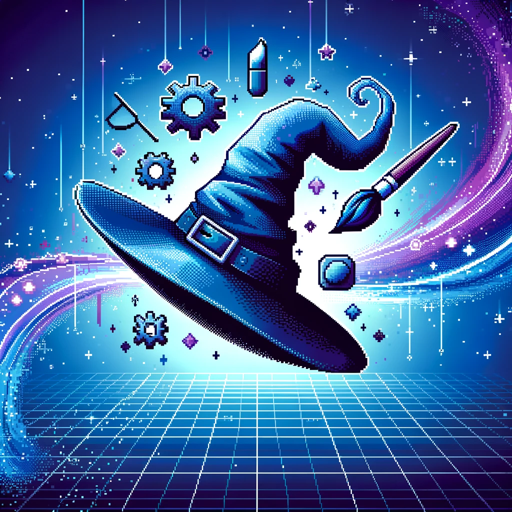Stable(S) Diffusion(D) Wizard Expert-AI-powered image generator
Transform text into stunning images with AI
Generate an image of a futuristic city.
Create a portrait of a fictional character.
Design a logo for a new tech startup.
Illustrate a scene from a fantasy novel.
Related Tools
Load More
Stable Diffusion Prompter
I generate art prompts for stable diffusion / animatediff.

Stable Diffusion提示词生成器
可能是最理解SD提示词结构的GPT了。Created by AI进化论-花生

Diffusion Master
Master of Stable Diffusion prompts.

Stable Diffusion Prompt Assistant
Artistic assistant for crafting Stable Diffusion prompts

Stable Diffusion Prompt Wizard
Guides on creating prompts for Stable Diffusion XL with model-specific advice.
Zizzifrax Baldur's Gate 3 Expert
Expert Baldur's Gate 3 Build Crafter & Item Locator
20.0 / 5 (200 votes)
Introduction to Stable(S) Diffusion(D) Wizard Expert
The Stable(S) Diffusion(D) Wizard Expert is designed to transform text-based descriptions into detailed images using the Stable Diffusion model. Its main functions are to assist users in generating high-quality, detailed images based on their text inputs. The system uses various tags and stylistic instructions to ensure the generated images meet the desired specifications. Examples include generating a realistic portrait from a simple description or creating a detailed landscape based on user input. This tool is highly useful for artists, designers, and content creators who need to visualize concepts quickly and accurately.

Main Functions of Stable(S) Diffusion(D) Wizard Expert
Text-to-Image Generation
Example
A user inputs 'A serene beach at sunset with gentle waves and palm trees.'
Scenario
The tool generates a high-quality image depicting a serene beach at sunset, complete with gentle waves and palm trees, using tags for quality and detail enhancement.
Customization with Styles
Example
A user specifies they want a painting in the style of Van Gogh.
Scenario
The tool uses style-specific tags and models to generate an image that mimics the distinctive style of Van Gogh, providing users with stylistically consistent visuals.
Iterative Refinement
Example
A user requests adjustments to an initial image, such as changing the lighting or adding new elements.
Scenario
The tool allows for iterative refinement of the image, enabling the user to make specific adjustments and enhancements until the desired result is achieved.
Ideal Users of Stable(S) Diffusion(D) Wizard Expert
Artists and Illustrators
These users can benefit from quickly visualizing their ideas and concepts, experimenting with different styles, and refining their work with detailed adjustments.
Content Creators and Marketers
This group can use the tool to generate high-quality visuals for marketing materials, social media content, and other digital assets, saving time and ensuring consistency in their visual branding.

How to Use Stable(S) Diffusion(D) Wizard Expert
Step 1
Visit aichatonline.org for a free trial without login, also no need for ChatGPT Plus.
Step 2
Familiarize yourself with the various model types available, such as Checkpoint, LoRA, and Textual Inversion.
Step 3
Choose the appropriate model for your needs from platforms like CivitAI, and download the models using the provided links.
Step 4
Use the recommended prompts and settings for optimal results, adjusting the prompt details to fit your specific requirements.
Step 5
Experiment with different prompt and model combinations to refine your images, making use of advanced settings like CFG scale and steps for further customization.
Try other advanced and practical GPTs
Marp diapo
Create stunning presentations effortlessly with AI

News Article Summarizer
AI-Powered News Summaries in Seconds
Finite Math Helper
AI-Powered Finite Math Solutions

Figure Generator
AI-powered Custom Figure Creation

Software Sven
AI-powered software solutions, tailored to your needs.

Copyleaks AI Bypasser
Enhance Your Text with AI Precision

GNU Radio Helper
AI-powered support for GNU Radio projects.

PERT/CPM Planner
AI-Powered Project Scheduling and Optimization

Video Generator
AI-Powered Video Creation and Editing

C# (Csharp)
AI-powered C# programming assistance

R3G - React Three Games
AI-Powered 3D Web Development Simplified

PDF Editor Pro
AI-Powered PDF Editing Made Simple

- Product Design
- Fantasy
- Artwork
- Portraits
- Landscapes
Q&A about Stable(S) Diffusion(D) Wizard Expert
What is Stable(S) Diffusion(D) Wizard Expert?
Stable(S) Diffusion(D) Wizard Expert is a tool designed to transform text-based descriptions into detailed images using various models and prompts, available for free without requiring login or ChatGPT Plus.
How can I access the models?
You can access and download the models from platforms like CivitAI. Each model has a download URL provided in the tool's documentation.
What are the different types of models available?
The tool supports Checkpoint models, LoRA models, and Textual Inversion models, each suitable for different styles and image requirements.
What are the key settings to optimize image generation?
Key settings include the sampler type, CFG scale, number of steps, and the use of clip skip. Each model has specific recommendations for these settings to achieve the best results.
Can I customize the prompts for better results?
Yes, you can customize the prompts by adding specific details and tags to control the style and composition of the generated images. Experimenting with different prompts and models is encouraged.